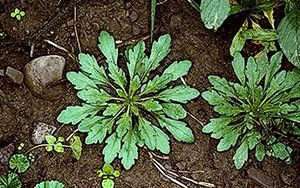Field Guide  Weed Management
Weed Management  Horseweed
Horseweed
Horseweed (Conyza canadensis)
Crop Impacts: Grain fields, soy bean fields, pastures & gardens
 | |
About Horseweed: |
Horseweed is a summer or winter annual weed that reproduces by releasing their seeds. This broadleaf plant establishes itself in vegetation and areas which have been disturbed. Horseweed grows very fast and is an aggressive weed that uses a lot of local water resources.
Family: Asteraceae


Horseweed Scouting and Prevention:
It has a straight stem that can stand to about 20 to 180 cm tall with many little branches protruding from it. As a seedling, the leaves of this weed are soft, hairy and bright green. As the plant gets older, the leaves become much harsher and narrowly oval in shape. They produce flowers that sit at the top of many short branches. This fluffy, yellowish flower blooms from July to late autumn. After the flowers open, the majority of the seeds begin to spread in late August to October and March to early May via wind.
Common locations
- - Gardens
- - Crop fields
- - Pastures
Horseweed Control:
The best way to deal with Horseweed is to spray 2,4D (1.0 lb acid equivalent per acre) between mid-October to late November. However, you cannot assume that this treatment will make your fields Horseweed-free in the spring. It is important that you scout your fields in the spring to see in any treatments such as supplemental herbicides or tillage would need to be done. Banvel (dicamba), Confront (clopyralid + triclopyr), Lontrel (clopyralid), Manor (metsulfuron), and Sencor (metribuzin) are also other chemicals that can help you keep this weed under control. If you have a preexisting population of Horseweed, do not plant soybeans.
It is important to note that in some areas Horseweed has become resistant to certain herbicides, which are:
- Glyphosate (WSSA group 9)
- Cloransulam (WSSA group 2)
- Glyphosate (WSSA group 9) and cloransulam (WSSA group 2)
- Paraquat (WSSA group 22)
Latin / Alternative Horseweed names:
- - Conyza canadensis
- - Marestail
- - Vergerette du Canada
Additional Horseweed Resources
http://www.omafra.gov.on.ca/english/crops/facts/ontweeds/canada_fleabane.htm
https://www.dowagro.com/range/weed/horseweed.htm
http://www.ipm.ucdavis.edu/PMG/WEEDS/horseweed.html
http://bulletin.ipm.illinois.edu/?p=1749
http://www.turffiles.ncsu.edu/weeds/Horseweed.aspx